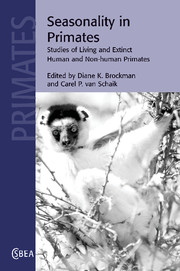Book contents
- Frontmatter
- Contents
- List of contributors
- Preface
- Part I Introduction
- 1 Seasonality in primate ecology, reproduction, and life history: an overview
- Part II Seasonal habitats
- Part III Seasonality and behavioral ecology
- Part IV Seasonality, reproduction, and social organization
- Part V Seasonality and community ecology
- Part VI Seasonality and human evolution
- Index
- References
1 - Seasonality in primate ecology, reproduction, and life history: an overview
Published online by Cambridge University Press: 10 August 2009
- Frontmatter
- Contents
- List of contributors
- Preface
- Part I Introduction
- 1 Seasonality in primate ecology, reproduction, and life history: an overview
- Part II Seasonal habitats
- Part III Seasonality and behavioral ecology
- Part IV Seasonality, reproduction, and social organization
- Part V Seasonality and community ecology
- Part VI Seasonality and human evolution
- Index
- References
Summary
Introduction
Seasonality refers to recurrent fluctuations that tend to have a period of one year. Seasonality in climate is a basic consequence of the tilt of the Earth's axis relative to its orbital plane (e.g. Pianka 1994). As a result, the position of the zenithal Sun (when it is directly overhead) varies through the year. It is directly overhead at 23.5° S on December 22 (winter solstice, in northern hemisphere terminology), then marches north, reaching the Equator on March 21 (equinox), moving on to the summer solstice on June 22 at 23.5° N, where it turns south again, passing the Equator on September 23 (another equinox) toward the winter solstice. The Sun's march affects not only sunshine but also other aspects of climate, such as windiness and rainfall. Hence, seasonality is felt around the globe.
This book is about the impact of seasonality on the lives of primates. Members of the order Primates are confined largely to the tropics, where they occupy a broad range of terrestrial habitats, although 90% of species live in tropical forest (Mittermeier 1988). Hence, our focus will be on seasonality in the tropics. In this region, seasonal variation in temperature is limited: temperature fluctuations over the 24-hour day exceed the range of monthly means and frosts are extremely rare (MacArthur 1972). Likewise, variation in day length, although present everywhere except right on the Equator, is limited. However, seasonal variations in rainfall and sunshine characterize all tropical habitats.
- Type
- Chapter
- Information
- Seasonality in PrimatesStudies of Living and Extinct Human and Non-Human Primates, pp. 3 - 20Publisher: Cambridge University PressPrint publication year: 2005
References
- 47
- Cited by

